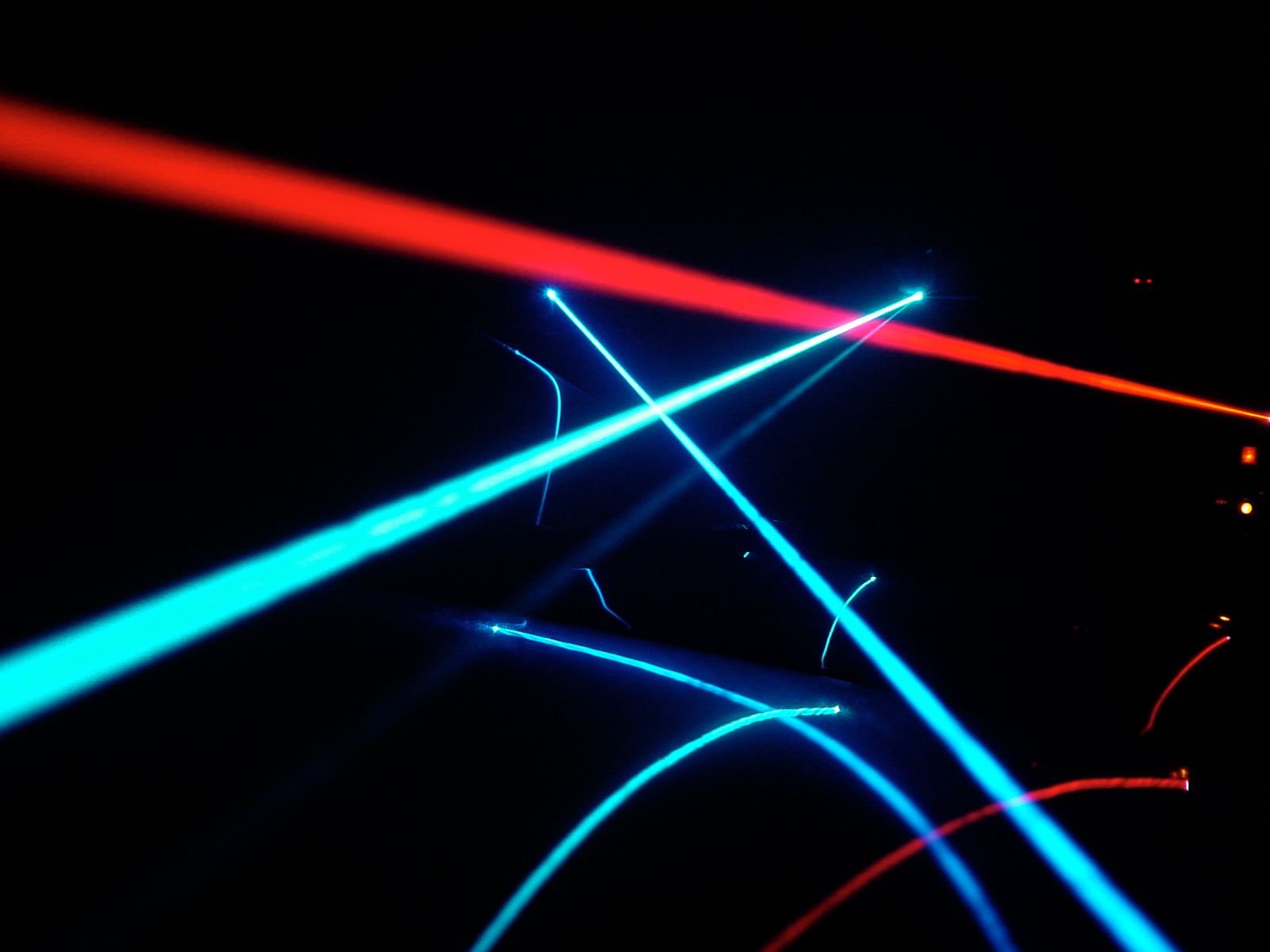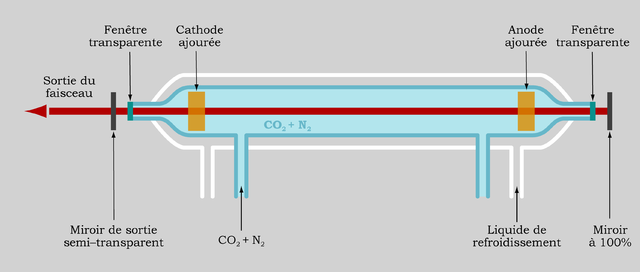Types of Laser Systems
Hi Steemians, today we will talk about types of lasers.

image source (Photo Credit: Jeff Keyzer)
Many types of laser [1] have been developed until today. These advanced lasers are superior to each other with many parameters such as maximum average power, maximum peak power, maximum pulse energy. Although the aims of these lasers are different, these are quite similar to each other in principle. The gain mentioned in this post which can be applied to all laser systems. So all these types of lasers, has a gain medium to generate beam in the system. The material (Yb, Er, Th, Ho, etc.) in the gain environment must be selected appropriately in order to get an emission. To overcome population inversion [2], the pump source is needed. This pump source can be either light source (pump diode) or electrical decharging. A cavity [3] which contains two mirrors (in fiber laser these mirrors can be fiber components) helps to amplification and generation of light. According to these parameters laser types can be continuous wave (cw) lasers [4] or pulsed lasers [5]. In this chapter, we will give some information about types of lasers such as gas laser [6], solid state lasers [7], chemical lasers [8], and finally fiber lasers [9].
## Gas Lasers
In gas lasers, some types of gas materials are used in low density for the gain medium. The gas materials may be atoms, ions or molecules. As the type of gas materials changes, the wavelength of the laser changes. These wavelengths are from 193 nm (excimer laser) to 10.7 μm (carbon dioxide laser). As examples, Helium, Neon, Argon or Carbon Dioxide can be given. The basic working principle of gas lasers is based on the resonant cavity system. The gain medium inside the resonant cavity is filled by gas materials according to the wavelength which is needed. The electrodes that are placed on the ground to contact the gas material are decharged and excites the gain medium. In other words, electrical energy is converted to laser energy. For example, in the He-Ne laser system [10], which is the most common gas laser system, for excitation of the Ne atoms, the He atoms are used as a gas material for the gain medium. The average optical powers of such lasers are quite low. So it can be used in hologram, interference and alignment.

As an example of carbon-dioxide laser (Photo Credit: Roland Brierre)
Carbon dioxide lasers [11] are another type of gas laser, have an average power of one hundred watts level. Carbon dioxide lasers are pumped by RF decharge usually and it is possible to obtain cw and pulse reigme. The efficeincy of such lasers is quite low. They are mostly used in cutting, drilling and so on for material processing.
## Solid State Lasers
In solid state lasers, the materials which is used for gain medium are solid and high density. The gain medium is either glass type or crystal type. For crystal types Al2O3, Y3Al5O2 can be given or for glass type SiO2 can be given as an example. The difference between glass and crystal materials is that glass is easy and cheap to produce, while crystals have better properties about heat resistance. Neodymium is the most common dopant species in solid state lasers. For example, Nd: YVO4, Nd: YLF or Nd: YAG. Among these, Nd: YAG [12] is the most widely used type with a wavelength of -1064 nm. Since it has high average power (kW level) it can be used for cutting, drilling for material processing in a very common way. Solid state lasers, can be cw or pulsed regime. Their overall efficiency is like gas lasers. Because of this efficiency problem, high-temperature problems are encountered while reaching high average optical powers. But nowadays, high-quality properties can be achieved with better materials and can reach kW levels. The best example with high average powers can be shown as thin disk lasers [14].

As an example of thin-disk laser (Photo Credit: US. Air Force)
## Chemical Lasers
In chemical lasers, chemical reactions take place for generation of energy. In this way, it is possible to obtain a laser at the megawatt level. The wavelength of the system may vary between 1300 nm and 4200 nm. Hydrogen fluoride laser [13] is one of the most common chemical laser species. These types of lasers are often referred to as "cutting" and "drilling". Due to the high average optical powers they can be also used as weapons.

As an example of chemical laser (Photo Credit: US. Army Photo)
## Fiber Lasers
Fiber lasers are the last ring of laser technology. In fiber laser systems, the cavity is formed by fibers (Yb, Er, Th, Ho, etc.) . Due to its practicality, resistance, cost-performance, easy handling, fiber lasers are better than other laser technologies. Fiber laser systems are similar in the traditional solid state laser systems. The light is transmitted in the fiber instead of air. Fiber technology makes fiber lasers systems, high efficient, reliable and compact system. Fiber laser systems are also capable of high optical power output. The most important reason is that fiber laser system, the light is transmitted almost without any losses (0.2dB/km). The geometric structure of the fibers helps to dissipate heat in a more efficient manner, thus the fiber laser system can be reach high optical power. Recent developments have resulted in an average output power of 10 kW in fiber laser systems. It is also possible to produce cw and pulsed regime for fiber laser systems.

As an example of fiber laser from our lab.
If you enjoyed this post, feel free to Upvote, Follow and Resteem.
All images used in this post are our own. You are welcome to use them with credit.
References are contained in Hyperlinks throughout the article. Everything else is my personal work.
Some of photos from my thesis and you can upload it from here.
Have a curious day, Steemians...

Gif Source (Photo Credit: @steemstem)
Hi @onderakcaalan, your images are not properly credited for use of the SteemSTEM tag, please check these guidelines:
https://steemit.com/steemstem/@steemstem/guidelines-on-copyright-standards-in-steemstem
Thanks for your warning. I will check the rules;)
We revised the sources of images. We hope this revision is good for SteemSTEM.
Congratulations! This post has been upvoted from the communal account, @minnowsupport, by onderakcaalan from the Minnow Support Project. It's a witness project run by aggroed, ausbitbank, teamsteem, theprophet0, someguy123, neoxian, followbtcnews, and netuoso. The goal is to help Steemit grow by supporting Minnows. Please find us at the Peace, Abundance, and Liberty Network (PALnet) Discord Channel. It's a completely public and open space to all members of the Steemit community who voluntarily choose to be there.
If you would like to delegate to the Minnow Support Project you can do so by clicking on the following links: 50SP, 100SP, 250SP, 500SP, 1000SP, 5000SP.
Be sure to leave at least 50SP undelegated on your account.